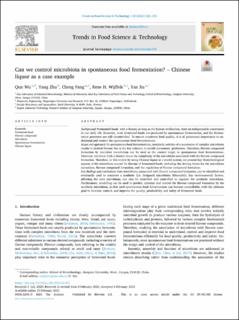| dc.contributor.author | Wu, Qun | |
| dc.contributor.author | Zhu, Yang | |
| dc.contributor.author | Fang, Cheng | |
| dc.contributor.author | Wijffels, Rene Hubertus | |
| dc.contributor.author | Xu, Yan | |
| dc.date.accessioned | 2022-07-14T11:42:22Z | |
| dc.date.available | 2022-07-14T11:42:22Z | |
| dc.date.created | 2021-06-14T13:02:38Z | |
| dc.date.issued | 2021 | |
| dc.identifier.citation | Wu, Q., Zhu, Y., Fang, C., Wijffels, R. H. & Xu, Y. (2021). Can we control microbiota in spontaneous food fermentation? – Chinese liquor as a case example, Trends in Food Science & Technology, 110, 321-331. doi: | en_US |
| dc.identifier.issn | 1879-3053 | |
| dc.identifier.uri | https://hdl.handle.net/11250/3005407 | |
| dc.description.abstract | Background: Fermented foods, with a history as long as the human civilization, form an indispensable constituent in our daily life. However, most fermented foods are produced by spontaneous fermentation, and the fermentation processes are still uncontrolled. To ensure consistent food quality, it is of paramount importance to understand and control the spontaneous food fermentations. Scope and approach: In spontaneous food fermentations, metabolic activity of a succession of complex microbiota results in desired flavour that is the key criterion to decide consumers’ preference. Therefore, flavour compound formation by microbial metabolism can be used as the control target in spontaneous food fermentations. However, relatively little is known about the complexity of the microbiota associated with the flavour compound formation. Therefore, in this review by using Chinese liquor as a model system, we present key biotechnological aspects of the microbiota crucial for flavour of fermented foods, including the driving forces for the microbiota succession, flavour compound formation, and the regulation of flavour compound formation. Key findings and conclusions: Core microbiota, associated with flavour compound formation, can be identified and eventually used to construct a synthetic (i.e. designed) microbiota. Meanwhile, key environmental factors, affecting the core microbiota, can also be identified and controlled to regulate the synthetic microbiota. Furthermore, modelling can be used to predict, optimize and control the flavour compound formation by the synthetic microbiota, so that such spontaneous food fermentations can become controllable, with the ultimate goal to monitor, control, and improve the quality, productivity and safety of fermented foods. | en_US |
| dc.language.iso | eng | en_US |
| dc.publisher | Elsevier | en_US |
| dc.rights | Attribution-NonCommercial-NoDerivatives 4.0 Internasjonal | * |
| dc.rights.uri | http://creativecommons.org/licenses/by-nc-nd/4.0/deed.no | * |
| dc.title | Can we control microbiota in spontaneous food fermentation? – Chinese liquor as a case example | en_US |
| dc.type | Peer reviewed | en_US |
| dc.type | Journal article | en_US |
| dc.description.version | publishedVersion | en_US |
| dc.rights.holder | © 2021 The Authors | en_US |
| dc.subject.nsi | VDP::Matematikk og Naturvitenskap: 400::Basale biofag: 470::Biofysikk: 477 | en_US |
| dc.subject.nsi | VDP::Matematikk og Naturvitenskap: 400::Kjemi: 440::Organisk kjemi: 441 | en_US |
| dc.subject.nsi | VDP::Teknologi: 500::Bioteknologi: 590 | en_US |
| dc.source.pagenumber | 321-331 | en_US |
| dc.source.volume | 110 | en_US |
| dc.source.journal | Trends in Food Science & Technology | en_US |
| dc.identifier.doi | 10.1016/j.tifs.2021.02.011 | |
| dc.identifier.cristin | 1915586 | |
| dc.relation.project | National Natural Science Foundation of China: 31530055 | en_US |
| dc.relation.project | National Key R&D Program of China: 2018YFD0400402 | en_US |
| dc.relation.project | Jiangsu Province Science and Technology Project: BE2017705 | en_US |
| dc.relation.project | LITE2018-12 | en_US |

